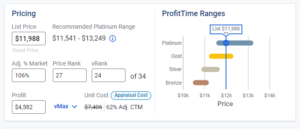A Misunderstood Aspect of Investment Value-based Pricing–“the Overlap”
When dealers use ProfitTime’s investment value-based method of pricing vehicles, they will often see vehicles where the ProfitTime price recommendation range doesn’t seem to make sense.
For example, a dealer might have a vehicle that ProfitTime ranks as a Platinum vehicle, the highest investment class in the system’s Bronze, Silver, Gold and Platinum scale. The dealers would expect that the vehicle should be priced like other Platinum cars.
But that’s not how the ProfitTime pricing system recommends the car should be priced. In fact, despite the vehicle’s ranking as a Platinum vehicle, the ProfitTime  pricing system suggests the vehicle should be priced as a Gold vehicle (see image at right).
pricing system suggests the vehicle should be priced as a Gold vehicle (see image at right).
Dealers often ask, “What gives? If it’s a Platinum car, why isn’t ProfitTime recommending a Platinum price?”
The answer goes to the heart of how the algorithms the ProfitTime system uses to determine vehicle investment values and recommended retail prices are different. For example, ProfitTime determines the investment value of a vehicle, and assigns an investment score and precious metal designation, strictly based on the vehicle’s Cost to Market, like-mine Market Days Supply and Retail Sales Volume. These three factors, in proper weighting for a specific vehicle, are statistically proven to predict the vehicle’s investment potential.
Meanwhile, the ProfitTime pricing algorithm accounts for these factors and then overlays others that have a more direct bearing on the vehicle’s retail sale. Such factors include the vehicle’s condition, its specifications and equipment, seasonality, current inventory and market dynamics and, importantly, the dealer’s demonstrated past retail performance with similar vehicles.
Hence, in the case of the Platinum vehicle in the illustration, the ProfitTime pricing algorithm knows that while the investment value of the vehicle is strong (due in part to the dealer’s highly favorable Cost to Market position), it also determined that there’s something about the vehicle and the circumstances around it that pose a risk for the dealer’s investment. It might be that the market doesn’t really care for the car, or perhaps the vehicle’s retail prospects face risk from other cars in the dealer’s inventory.
As a result, the ProfitTime pricing algorithm recommends a retail asking price that’s more akin to Gold vehicles than other Platinum vehicles in the dealer’s inventories. At vAuto, we call such occurrences “overlaps.” The overlaps represent situations where the ProfitTime pricing system recommends a price for a vehicle in an investment category that overlaps with a different investment category.
It should be noted that the overlaps can occur with vehicles in any of ProfitTime’s Bronze, Silver, Gold and Platinum investment categories. In addition, the overlaps can go both ways. For example, a dealer could have a Bronze vehicle for which the ProfitTime pricing system recommends a Silver-level price, due to a positive attribute that distinguishes the vehicle and its optimal retail price range it from other Bronze vehicles.
When dealers ask about their overlap vehicles, I’ll assure them that it’s a good thing. The presence of pricing overlaps for their vehicles demonstrates that the ProfitTime pricing algorithm is doing exactly what it’s supposed to do. It’s finding the most optimal retail price range recommendation for a vehicle, given all the opportunities and risks at hand.
In this way, the ProfitTime pricing algorithm is doing what dealers and used vehicle managers sometimes are challenged to do–pricing cars based on the dispassionate, objective truth of a vehicle’s investment value, in conjunction with all the other price-relevant factors surrounding the car.
